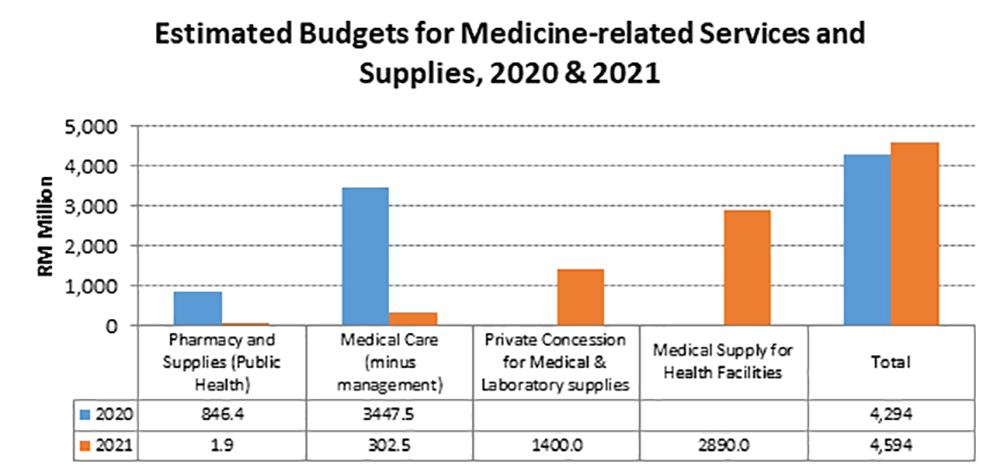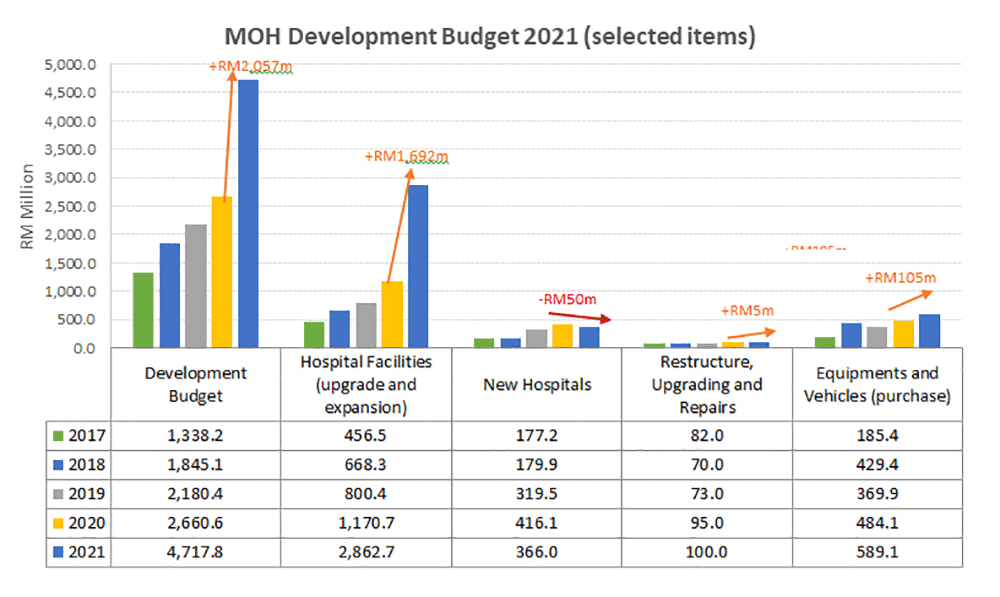LETTER | The night after the Budget 2021 was read out in Parliament, many were shocked and angered that the government contemplated on "slashing the budget" heavily on many medical programmes.
People thought this was the "compromise" for shifting more resources to fighting Covid-19 (since these endeavours were read out loudly and clearly in the Budget speech), as well as to development expenditure.
For the latter, it is not surprising that the public feels this way, since they look at the total Health Ministry budget which increased by RM1.3 billion. An additional RM2.1 billion goes to development expenditure but RM718 million was reduced for the operating budget.
Patient groups including those who suffer from kidney, heart or cancer health problems, found it terrifying to be told that their concerning programmes have had their budget cut by more than 50 percent. In fact, some of them went to see the extract of the estimated expenditure themselves, and were convinced that those allocations for "services and supplies" (which carry the budget line item code 20000) that bought them medicines are all mysteriously zero.
I did find the anomalies but at the same time, I also managed to locate two new budget allocation items, one under the section “Specific Programmes”, entitled "Medical Supply for Health Facilities" (worths RM2.89 billion) and another one under the new section “Financial Commitment”, entitled "Private Concession for Medical and Laboratory supplies" (worths RM1.4 billion) (Figure 1).
When I summed them up and compared it with the Budget 2020 total amount, it suggests that the Ministry of Finance probably has given RM300 million more for the purpose of purchasing medical products and laboratory supplies.

Last night the Finance Minister Tengku Zafrul Abdul Aziz issued a clarification statement confirming my suspicion that the budget item reclassification is the main culprit for the great confusion, anxiety and outrage expressed by the public.
I would not blame the average Joe and Jane for the misunderstanding and misreading, the government should remember well the mantra: “If it ain’t broke, don’t fix it”. Yes, central procurement by the government has been a practice for a long time, and private concession given to procure APPL list of drugs is also not new, these should not be the reason for reclassification.
Those "affected" programmes should be restored and given an allocation (on the code 20000 line item) for the sake of budget clarity, transparency and accountability so that the public could track and understand the constraint of resources in each programme.
A centralised and pooled figure, although it may serve the Health Ministry well for the flexibility of allocating according to immediate needs, could have unintended consequences of causing unnecessary anxiety and stress to the doctors and management officers in various medical departments as well as the patients, worrying if the common pool has been dried up or if their request is in competition with other medical programmes for the scarce resource – the more unknown, the more insecure one becomes.
However, given that Health Ministry is currently enjoying high public confidence and approval, and on many occasions, we have heard Health director-general Dr Noor Hisham Abdullah championing for strengthening public health, my hope was high to expect the ministry could secure much improved and significantly higher budget than normal projection.
I am disappointed to find the percentage growth (4.4 percent) and absolute amount (RM1.3 billion) is the smallest since 2017. I find it a bit disturbing to see the total operating budget allocation for "services and supplies" reduced by nearly RM1.3 billion even if the medical supplies are not affected.
For the disease control division under the Public Health Department, not only the allocation amount for "services and supplies" reduced, the number of positions in that division did not grow too (but effectively was deducted by one). This might send the wrong signal to the public that the ministry does not want to invest more in disease control given what has happened, not just with Covid-19, but the good old dengue problem and the ever-rising non-communicable diseases. Rabies and polio outbreak threats are coming back to haunt too.
Not all is gloomy, I am particularly pleased that this time the Health Ministry has heeded many calls to invest more in maintaining and expanding infrastructure. It may well be because it has been a long-overdue call. Attention has always been given on the physical capacity of the facilities attending to so many patients; some are concerned about the state of maintenance of the buildings especially after the frustration vented by a doctor in Sabah last May highlighting the dilapidation of health facilities there.
Make no mistake, the development expenditure (DevEx) budget for 2021 is a historic high at RM4.7 billion. Whether this decision was made due to the economic impacts and benefits of construction projects that it would bring to the local community, perhaps the Finance Minister could help clarify, but investment of this kind is never too late.
Budget allocation for upgrading and expanding hospital facilities is by far the largest, it took 60.7 percent of the DevEx, or RM2.86 billion (Figure 2).
During the Covid-19 pandemic period, it is good to see the government planning ahead and thinking about the future capacity to meet an expected surge in public healthcare demand. Allocating more resources for vehicles and equipment purchase is also a wise decision, given that the district health offices might need more mobility for Covid-19 screening and monitoring related activities at the community level.

The government pledged another RM20 billion to the Covid-19 Fund, making it a total of RM65 billion especially for tackling the epidemic nationwide. Currently, the third wave is still at peak infection power, perhaps people are concerned if the budget allocated for fighting Covid-19 is sufficient.
First, we were told that the government reserved more than RM3 billion to vaccine procurement, planning to immunise at least 70 percent of the population. After calculation, for a vaccine course of two doses per person, the government would have a working budget of RM131 per person, which is higher than the average estimate made by Covax facility for a person. Alternatively, the government could even simply purchase more and go beyond the 70 percent coverage.
RM1 billion budget allocation was announced for various Covid-19 fighting purposes, such as the purchase of personal protective equipment (PPE) (RM318 million) and Covid-19 test kits (RM475 million). For PPE, if the amount is divided by 100,000 of medical frontliners in this country, they would have an average personal annual budget worth of RM3,180 or about RM10 per work day. Depending on what medical specialisation or expertise the person has, it could well be sufficient.
For the Covid-19 test kits, let’s say next year the same number of persons undergoing screening is about 2.26 million as of Nov 7, if the cost can be kept at RM100 per person or lower, the current budget allocation should allow Malaysia to weather through twice the current screening amount.
Perhaps with the large reserve of RM65 billion in the Covid-19 fund, we should worry less about the financial implication of the government’s effort, but more for them in getting enough helping hands (for example, expertise or volunteers) to address the pandemic.
All in all, not many candies were tendered out during this Budget 2021 presentation sweet enough to call it an election budget. Even if this is just a Health Ministry budget without a wow factor, I wish next year everyone stays in good health. It is not too bad, (election) candies may not be good for your health.
The views expressed here are those of the author/contributor and do not necessarily represent the views of Malaysiakini.

